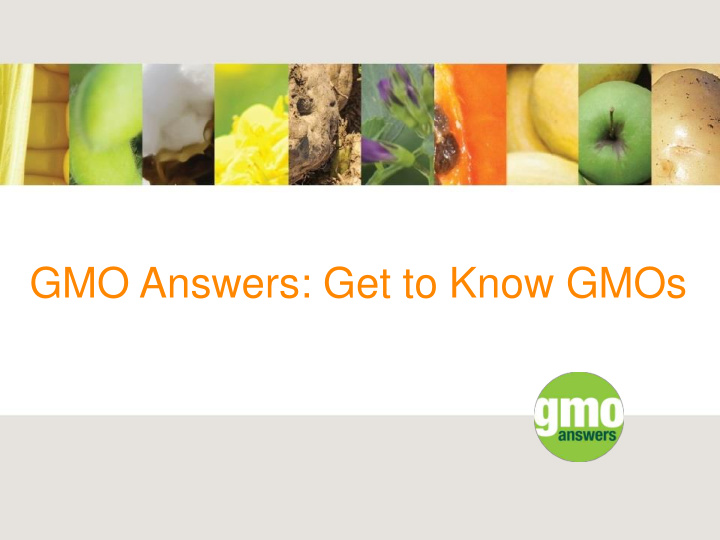



GMO Answers: Get to Know GMOs
Introducing GMO Answers
Answering Consumers’ Questions
Social Media
Social Media
Resources: Materials, Visuals & Videos Visit GMOAnswers.com/educational-resources to download, print or share.
Resources: Mythbusters Visit GMOAnswers.com/educational- resources or the GMO Answers’ Pinterest page to access mythbusters.
Get to Know GMOs Topics we’ll cover: 1. Common Misconceptions 2. GMO Basics & Science 3. GMO Answers Resources
The top five misconceptions see across social media are: #1. If it’s extra -large, seedless, looks weird, tastes bad and feels squishy – it must be a GMO. #2. GMOs aren’t safe and they’re only tested by the companies making them. #3. There is animal DNA in GMOs. #4. GMOs have pesticides injected into them. #5. GMO companies force farmers to grow their crops, or sue farmers if GMO seeds or pollen blow into their fields.
Myth-busting #1
Myth-busting #2 Crops from GM seeds are studied extensively to make sure they are safe - an average of 13 years and $136M 1 Hundreds of independent studies can be researched at Biofortified.org. Frank N. Foode™ 1 McDougall,P. (2011). The Cost and Time Involved in the Discovery, Development and Authorization of a New Plant Biotechnology Derived Trait.
Myth-busting #3
Myth-busting #4
Myth-busting #5 Farmers choose what seeds to grow based on: • What is best for their farms • Local growing environments • Consumer demand Many farmers successfully grow, on the same farm, all three of these crops:
What is a GMO? GMOs are crops developed with genetic engineering, a more precise breeding technique, that enables someone to take individual traits found in nature and transfer them to another plant, or make changes to an existing trait in a plant.
How We Got Here
Why GMO? SEED IMPROVEMENT THIS CHART COMPARES AND CONTRASTS MODERN METHODS OF SEED IMPROVEMENT. How do we create new and improved varieties of plants? It starts with the seed. Plant breeders and scientists work together to create new varieties to address evolving challenges to farming and changing consumer preferences. Humans have been central in seed improvement for over 10,000 years, and in the last 100 years our understanding of genetics has accelerated and enabled new seed improvement techniques. Compared to earlier methods, breeders can now make improvements to seeds by moving more precisely one or a few genes into a seed.
Why GMO? Insect resistance Season-long protection against target pests, reduces the need for pesticide applications, and lowers input costs. Drought resistance Ability to grow in much drier areas, conserving water and other environmental resources. Herbicide tolerance Fight weeds by applying herbicides only when needed and enabling farmers to use no-till production methods that preserve topsoil, prevent erosion, and reduce carbon emissions. Disease resistance With GM, the Hawaiian papaya industry was able to recover from the devastating papaya ringspot virus that had crippled the industry. Enhanced nutritional High-oleic soybeans have been genetically modified to produce oil with more profile monounsaturated fat, less saturated fat and little-to-no trans fat. Other GM crops are still being developed for nutritional improvement, including Golden Rice, which includes β -Carotene that could deliver vitamin A to children in developing nations.
How is a GMO made? https://www.youtube.com/watch?v=2G-yUuiqIZ0
How is a GMO made?
Who grows GMOs?
How do we ensure that GMOs are safe for use and consumption? • GMO crops are studied extensively to make sure they are safe for people, animals and the environment • GM seeds take an average of $136 million and 13 years to bring to market because of research, testing and regulatory approvals conducted by government agencies in the United States and around the world. 1 1 McDougall,P. (2011). The Cost and Time Involved in the Discovery, Development and Authorization of a New Plant Biotechnology Derived Trait
GMO Safety: Safe to Eat • GMOs available today are as safe as their non-GMO counterparts. • They do not cause new allergies, cancer, infertility, ADHD, autism or any other diseases or conditions. • The safety of GMOs has been affirmed by:
GMO Safety: Safe for the environment Biotech crops have reduced agriculture’s environmental footprint: • Increased yield on current land prevents further deforestation and protects ecosystems • Fewer pesticide applications • No/reduced tillage with GM HT technology means less tractor fuel consumption and emissions “In 2013, the permanent CO2 savings from reduced fuel use associated with GM crops was 62 billion pounds. This is equivalent to removing 12.4 million cars from the road for a year .” - Graham Brookes, Agricultural Economist, PG Economics Ltd
GMO Safety: Safe to Grow When testing, researchers look for any difference between the GM and non-GM plants to make sure the GM variety grows the same as the non-GM variety. They are also tested to make sure they do not unintentionally harm non-target, beneficial insects, like honey bees and ladybugs.
What do the GMOs of the future look like?
Recommend
More recommend